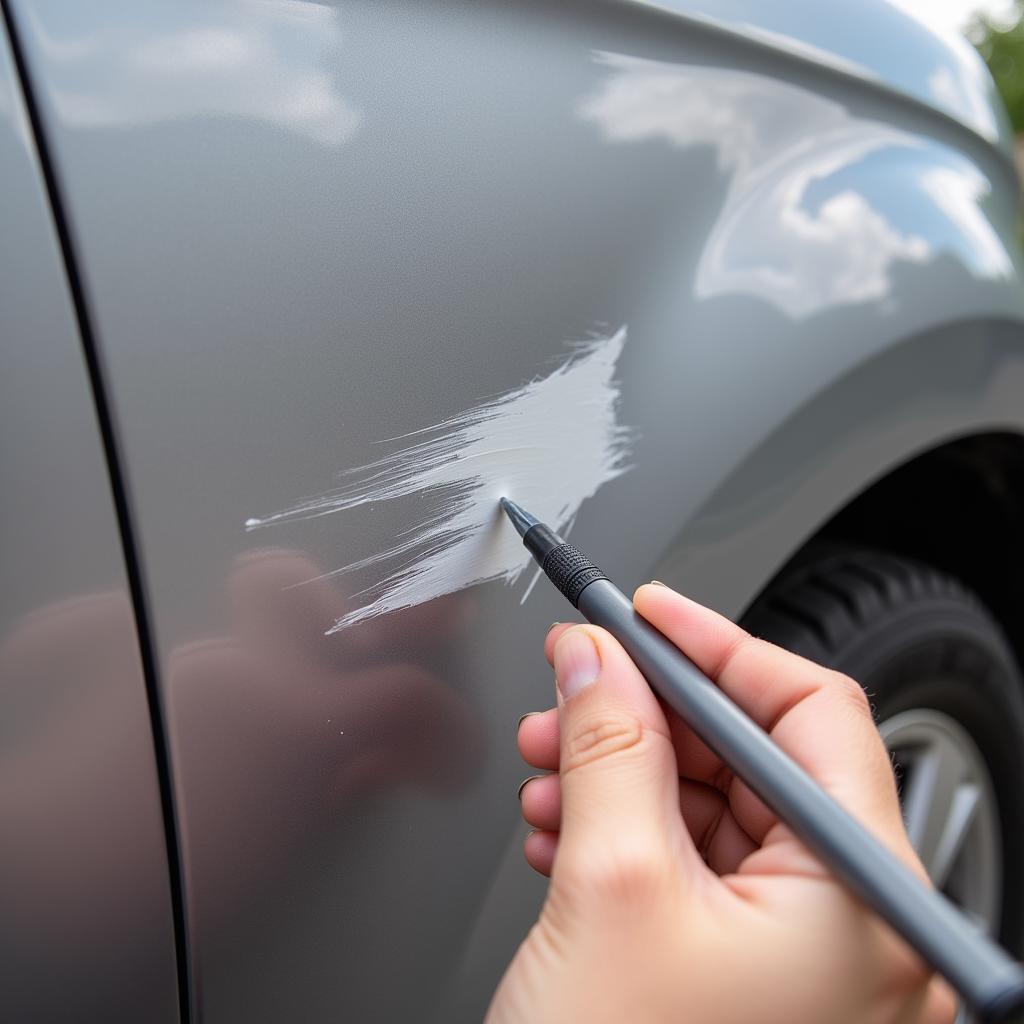Fixing a deep scratch into your car’s paint can be a frustrating experience, but with the right approach, you can achieve professional-looking results without breaking the bank. This guide provides a comprehensive walkthrough for car owners, repair shops, and technicians on how to effectively address deep paint scratches.
Assessing the Damage and Gathering Supplies
Before you begin Fixing A Deep Scratch Into Paint On Car, it’s crucial to assess the extent of the damage. A deep scratch, unlike a minor surface scratch, penetrates through the clear coat and possibly the base coat, exposing the primer or even bare metal. Determine the depth and length of the scratch to choose the appropriate repair method. After assessing the damage, gather your supplies. This typically includes sandpaper (2000-grit, 3000-grit), rubbing compound, polishing compound, car wash soap, microfiber towels, masking tape, primer (if necessary), touch-up paint, and clear coat. For deeper scratches that reach the metal, you might also need rust remover.
 Assessing a Deep Paint Scratch on a Car
Assessing a Deep Paint Scratch on a Car
Preparing the Scratched Area
Thoroughly wash and dry the scratched area. Use masking tape to protect the surrounding paint from accidental sanding or overspray. Similar to fixing scratch on car, preparing the area properly is essential. For deeper scratches that have reached the metal, apply a rust remover to prevent future corrosion. Once the area is clean and dry, start sanding with 2000-grit sandpaper, using gentle, back-and-forth motions. The goal is to smooth out the edges of the scratch and create a level surface for the touch-up paint.
Applying Primer and Touch-Up Paint
If the scratch has penetrated through the color coat to the primer or metal, apply a thin layer of automotive primer to the affected area. Allow the primer to dry completely before proceeding. Next, carefully apply the touch-up paint to the scratch, using a fine-tipped brush or a touch-up pen. Apply multiple thin coats, allowing each coat to dry before applying the next, rather than one thick coat. This will prevent runs and ensure a smooth finish.
 Applying Touch-Up Paint to a Car Scratch
Applying Touch-Up Paint to a Car Scratch
Leveling and Blending the Repair
Once the touch-up paint is dry, wet sand the area with 3000-grit sandpaper. This will level the touch-up paint with the surrounding area and create a smooth, uniform surface. Fixing a deep scratch into paint on car requires meticulous attention to detail during this blending process. Rinse the area and dry it thoroughly. Next, apply rubbing compound to the repaired area using a microfiber applicator pad. Work in small, circular motions, applying moderate pressure. This process removes any remaining imperfections and begins to blend the repair with the surrounding paint. Follow up with a polishing compound to restore the shine and gloss to the repaired area.
Final Polishing and Waxing
After the rubbing and polishing compound steps, the repaired area should blend seamlessly with the surrounding paint. As with how to fix a deep scratch on a silver car, the final step is to apply a coat of wax to the entire area to protect the finish and add an extra layer of shine. This final step will leave your car looking its best.
Conclusion
Fixing a deep scratch into paint on car requires patience and attention to detail, but the results are well worth the effort. By following these steps, you can restore your car’s appearance and protect it from further damage. For personalized assistance with your car repair needs, feel free to contact us at AutoTipPro. Our phone number is +1 (641) 206-8880, and our office is located at 500 N St Mary’s St, San Antonio, TX 78205, United States.
Expert Insight:
- John Smith, Automotive Paint Specialist: “Always apply thin coats of touch-up paint to avoid runs and ensure a smooth finish. This is especially important when fixing a deep scratch into paint on car.”
- Maria Garcia, Auto Body Repair Technician: “Proper sanding is crucial for blending the repaired area with the surrounding paint. Take your time and use the correct grit sandpaper to achieve a seamless repair.”
- David Lee, Car Detailing Expert: “Don’t underestimate the importance of the final polishing and waxing stages. These steps restore the shine and protect the repaired area, ensuring a long-lasting, professional-looking result. This applies to any car paint repair, including instances like how to fix bubbling paint on car. “
This approach holds true even for specific situations like how to fix a deep scratch on a silver car. Also, if you’re dealing with more extensive body damage, you might find our guide on how to fix deep dents in car helpful. For more general car paint repair advice, check out how to fix my car paint damage.





Leave a Reply